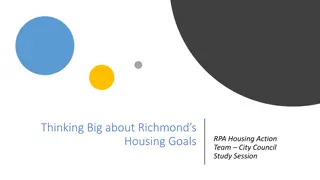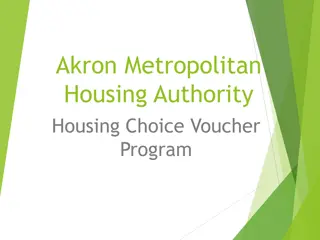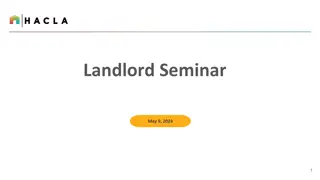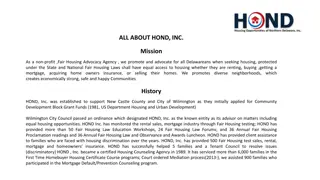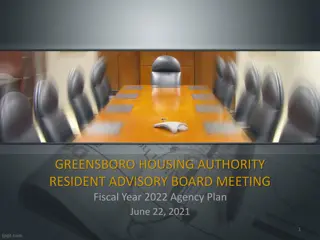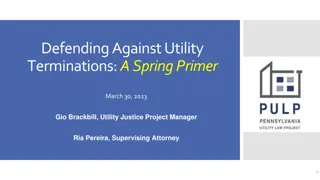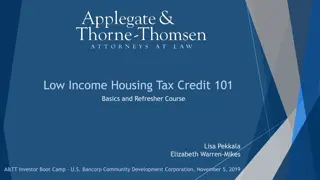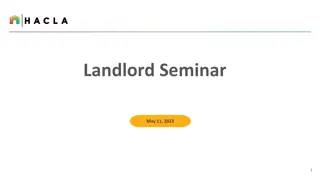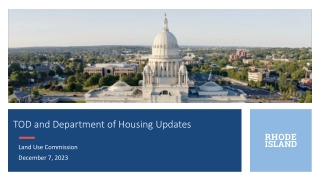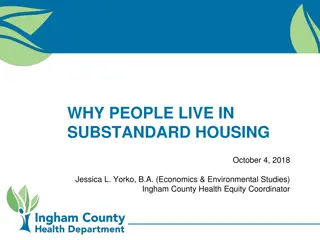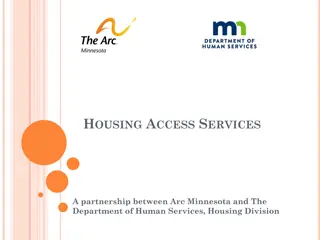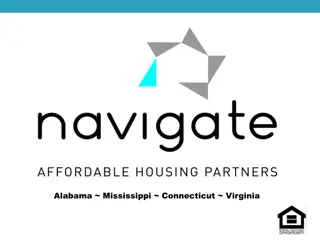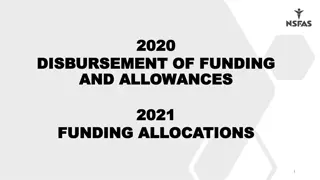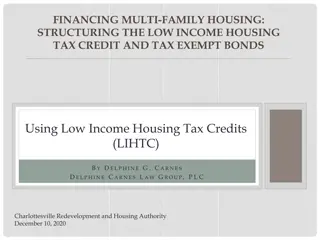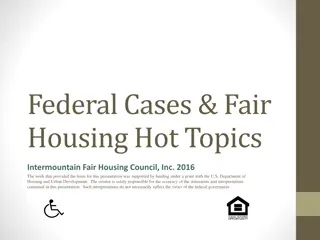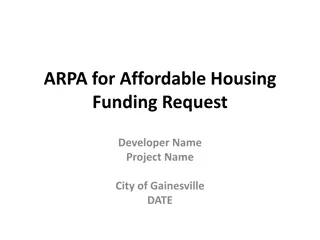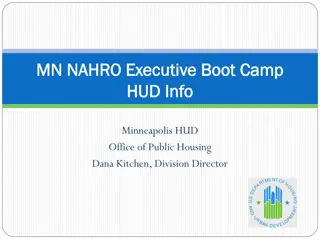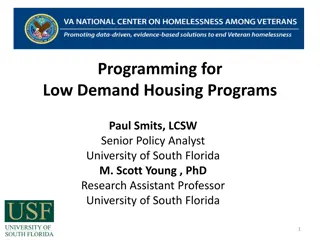Understanding Utility Allowances for Affordable Housing Programs
Utility allowances play a crucial role in determining rents for affordable housing properties financed with federal and state funding sources. This article covers the concept of utility allowances, determining the correct UA to use, LIHTC and HOME programs, responsibilities, implementation, documentation, non-compliance consequences, and tips for compliance in the affordable housing sector.
Download Presentation

Please find below an Image/Link to download the presentation.
The content on the website is provided AS IS for your information and personal use only. It may not be sold, licensed, or shared on other websites without obtaining consent from the author. Download presentation by click this link. If you encounter any issues during the download, it is possible that the publisher has removed the file from their server.
E N D
Presentation Transcript
AGENDA Basic Utility Allowance Concept Determining the correct UA to use LIHTC SubMetering HOME Pre 8/23/2013 and HOME Post 8/23/2013 Responsibilities, Implementation and Documentation Non-Compliance and Tips to remain in Compliance Exercise
WHAT IS A UTILITY ALLOWANCE? Owners of properties financed with most federal and state funding sources must limit rents and incomes to no more than the Area Median Gross Income (AMGI) annually as published by HUD. An allowance for the cost of any utility, other than telephone, cable television, or Internet, paid directly by the tenant and not through the owner of the building is included in the computation of gross rent.
WHAT IS A UTILITY ALLOWANCE CONTINUED When working with utility allowances, owners/agents must only count the utilities for which the household is responsible for paying. If the owner pays all of the utilities, than the utility allowance is zero. The maximum rent that may be paid by the tenant must be reduced by the utility allowance.
DETERMINING THE CORRECT UA TO UTILIZE The Utility Allowance method of calculation that can be used is based on the specific funding at the property. When reviewing the UA it is important to know the funding source(s) involved and how they may or may not work together. 1) LIHTC 2) HOME (Pre or Post 8/2013 funding) 3) Project Based Sec 8 or RD 4) HCV Section 8 households
LIHTC WITH MIXED FUNDING PBV/HCV LIHTC Property UA s are calculated on a building by building basis. It is possible for LIHTC Property UA s are calculated on a building by building basis. It is possible for different buildings to have different UA s depending on funding sources involved. different buildings to have different UA s depending on funding sources involved. 1. Rural Housing Service Properties (Rural Development or RD) - Buildings assistance from RHS must use the allowances provided by RHS for all rent restricted units in the building Buildings receiving 2. HUD Regulated Properties- Buildings required to have rents and utility allowances reviewed annually by HUD must use the HUD provided utility allowance for all rent restricted units. Buildings that receive HUD rental assistance or are 3. If buildings are restricted by both RHS and HUD, the RHS numbers must be used for those buildings buildings. 4. Tenants Receiving HUD Rental Assistance- Units tenant based rental assistance must use the applicable PHA utility allowance established for the Section 8 existing housing program. Units housing tenants receiving HUD
LIHTC UA METHODS NO PBV HUD/RD 1. 1. Public Housing Authority (PHA) Utility Allowance Public Housing Authority (PHA) Utility Allowance- - This is the most common utility estimate method used by LIHTC properties that are not regulated by RHS or HUD. Most PHA allowances are published by the Housing Authority for each County on at least an annual basis. If multiple local PHA s serve one area, owners must choose the PHA that serves the property location. Each PHA is required to review and update utility allowance information on an annual basis and publish new calculations if there has been a ten percent or more (either higher or lower) change since the utility schedule was last revised. 2. 2. Utility Company Estimates Utility Company Estimates- - Utility Company estimates may be obtained in writing from a local utility provider. This method requires written documentation from the utility company stating that the rates are estimates for this specific property . Must be on the Utility Company letterhead and list specific amounts for each bedroom size. Most utility companies base their estimate on actual consumption and require signed authorizations of release of information from each tenant living at the property.
LIHTC UA NO PBV HUD/RD CONTINUED 3 3. Agency Estimates Agency Estimates- - OHCS does not calculate at this time 4. HUD Utility Schedule Model HUD Utility Schedule Model- - (HUSM) estimate using the HUD Utility Schedule Model that can be found on the LIHTC page at http://www.huduser.org/portal/resources/utilmodel.html. Owners using this model must maintain and provide documentation providing the source and content of all factors entered into the model spreadsheet. Rates input must not be older than the rates in place 60 days prior to the date the utility allowance will change. (HUSM) A building owner may calculate a utility 5. 5. Energy Consumption Model Energy Consumption Model- - A building owner may retain the services of a qualified professional or properly licensed engineer to calculate utility allowances based on an energy consumption model (also known as an energy and water/sewage consumption and analysis model). The calculator must be pre-approved by OHCS.
SUBMETERING Sub-Metered Utilities are acceptable to be used when calculating a utility allowance as long as the individual unit is metered and the utility costs paid by the tenant are based on actual consumption are based on actual consumption. In this case the IRS has stated that utility costs paid by a tenant and based on actual consumption are to be treated as paid directly by the tenant. Utility rates charged to the tenant in a sub-metered unit must be limited to the utility company rates incurred by the manager or owner. (Ratio Utility Billing System) The RUBS method is based on an allocation formula which takes into consideration the number of occupants, unit square footage, number of bathrooms, and number of water heaters. The RUBS method is not acceptable by the IRS acceptable by the IRS for determining a utility allowances as the allocation method is not based on tenant actual consumption. Buildings that use the RUBS method must consider the cost paid by the tenant as a non-optional fee and the fee must be included in the maximum allowable rent calculation. The RUBS method is not
PRE AND POST HOME UA CALCULATIONS P R E F I N A L R U L E F U N D E D B E F O R E 8 / 2 3 / 1 3 P O S T F I N A L R U L E F U N D E D O N / A F T E R 8 / 2 3 / 1 3 Can use all UA calculation methods as approved by PJ Must be based on actual consumption Can use all UA calculation methods as approved by PJ with exception of the PHA. Cannot use PHA Cannot use PHA. Must be based on actual consumption Emphasis on HUSM
OWNER RESPONSIBILITIES Utility allowances must be reviewed annually must be reviewed annually to ensure that allowances used are comparable to what the LIHTC tenant is actually paying. Owners may choose to review allowances more than once per year however, each time a review is completed, whether a mandated annual review, or a self-imposed review, owners and agents have a maximum of 90 days after the new allowances are determined to implement them into the maximum allowable rent computation.
90 DAY PERIOD IMPLEMENTATION The 90 day implementation period begins for: PHA PHA- - When the PHA makes the revision available Utility Company Utility Company- - with receipt date of the new information HUD Model HUD Model- - the date entered as the form date on the HUD form 52667 Energy Consumption Model Energy Consumption Model- - 60 days after the end of the last month of the 12-month period used to compute the estimate
NOTIFICATION REQUIREMENTS Obtained UA from PHA Obtained UA from PHA- - If the Owner obtained a utility allowance from the PHA the owner must make the utility allowance calculation notification available to all tenants at the beginning of the 90 day period. Obtained UA from utility company, using the HUD Model, or Energy Obtained UA from utility company, using the HUD Model, or Energy consumption model consumption model- - the owner must submit copies of the utility calculations with supporting documentation to OHCS and make the calculation available to all tenants in the building at the beginning of the 90 day period. Must have had method approved previously/consecutively if changing from PHA method. OHCS may require additional documentation from owner during the 90 day period.
CHANGING METHODS Owners are not prohibited from changing methods used for calculating a utility allowance in order to most accurately calculate the utility allowance. OHCS must be notified of the change per the notification requirements listed on the previous slide and must approve the provider of the energy consumption model calculation if applicable. . The change proposed must meet all funding source restrictions at The change proposed must meet all funding source restrictions at the property. the property.
COST OF CALCULATION AND NOTIFICATION Cost of estimates: The building owner is responsible for the costs incurred in obtaining the utility allowance calculations. The building owner must also pay the cost of notification to the tenants and OHCS.
PROOF OF NOTIFICATION UA calculation documentation must be kept on file in order to provide proof of compliance during the entire credit period and made available to the IRS or OHCS on request. Owners or agents must submit the utility allowance documentation paperwork to OHCS each year with the CCPC, at inspection, and when requested. The information must be made available to all tenants at the beginning of the 90 day period before the new utility allowance can be used to calculate rent. Proof of resident notification should be kept on file for OHCS review.
UA COMMON NON-COMPLIANCE The appropriate utility allowance is not used for funding source involved The utility allowance is not calculated properly Rents are not reduced when the tenant is paying for the utility Owner/agent did not review the basis on which the utility allowance was Owner/agent did not review the basis on which the utility allowance was established at least once during the calendar year established at least once during the calendar year Owner failed to update rents for a UA change within the 90 day period Owner failed to update rents for a UA change within the 90 day period Owner failed to maintain adequate documentation regarding the computation of utility allowances. *Please note that without proof of the UA or how it was calculated, there is no way to correctly calculate the rent.
CONSEQUENCES OF NON-COMPLIANCE LIHTC: LIHTC: Once a unit is determined to be out of compliance with the rent limits and it is determined that a tenant has overpaid rent for even one month, the unit ceases to be a low-income unit for the remainder of the owners tax year. An owner cannot avoid the disallowance of the LIHTC by rebating the excess rent or fees to the affected tenants. OHCS will require that the over charged rent is refunded; however, this will not bring the unit back into compliance. Properties in first 15 will be subject to recapture via IRS form 8823. HOME and Other funding sources: HOME and Other funding sources: At a minimum OHCS will require that the over charged rent is refunded retroactively. The status of the Owner and/or Agent may be considered to be at risk
TIPS TO REMAIN IN COMPLIANCE Check, calculate and change utility allowance at least once per calendar year as applicable Make sure that the utility allowance used is a method approved by OHCS and the IRS Reduce rents within time frame allowed if applicable Consider maintaining a buffer below maximum rents so that a change in utility allowance does not put the property rents out of compliance Maintain all documentation required to show proof of compliance Submit required documentation to OHCS as required Notify tenants of utility calculations when required Know the difference between actual sub-metering and RUBS Obtain OHCS approval before changing methods of calculation
TIPS TO REMAIN IN COMPLIANCE CONTINUED Know the requirements for all funding sources at the property When utilizing the ECM make sure that you are using a qualified calculator or that your calculator is approved by OHCS before modeling the property. Do not obtain an ECM for any LIHTC building that contains one or more project based units. If utility costs decrease the rents should not automatically increase. OHCS approval must be received before raising rents. When in doubt talk it out with OHCS before implementing change. Contact Jennifer When in doubt talk it out with OHCS before implementing change. Contact Jennifer Marchand Marchand or Allen or Allen McCartt McCartt with questions or concerns! with questions or concerns!
THANK YOU FOR ATTENDING On behalf of the whole OHCS Compliance and Asset Management team we thank you for attending today! Please let us know how we can help you maintain compliance. Jennifer Marchand Multifamily Program Compliance Technical Advisor 503-986-2031 Voice Jennifer.C.Marchand@Oregon.gov (email) Oregon Housing and Community Services 725 Summer Street NE, Suite B Salem, Or. 97309-0409 http://www.ohcs.oregon.gov In some cases asking for advice is better than asking for forgiveness!






